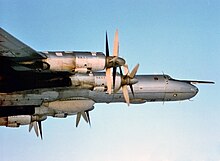Tupolev Design Bureau
Tupolev Tu-142 Bear-F/J
 |
|
| A Tu-142 of the Russian Navy. | |
| Role | Maritime patrol and anti-submarine warfare aircraft |
|---|---|
| National origin | Soviet UnionRussia |
| Design group | Tupolev |
| Built by | Kuibyshev Aviation PlantTaganrog Machinery Plant |
| First flight | 18 July 1968 |
| Introduction | December 1972 |
| Retired | 2017 (India) |
| Status | Out of production, in service |
| Primary users | Russian Navy Soviet Navy (historical) Indian Naval Air Arm (historical) |
| Produced | 1968–1994 |
| Number built | 100 |
| Developed from | Tupolev Tu-95 |
|
|
.
History Public Joint Stock Company Tupolev,
Tupolev Tu-142 Bear-F/J

The Tupolev Tu-142 (Russian: Туполев Ту-142; NATO reporting name: Bear F/J) is a Soviet/Russian maritime reconnaissance and anti-submarine warfare (ASW) aircraft derived from the Tu-95 turboprop strategic bomber. A specialised communications variant designated Tu-142MR was tasked with long-range communications duties with Soviet ballistic missile submarines. The Tu-142 was designed by the Tupolev design bureau, and manufactured by the Kuibyshev Aviation and Taganrog Machinery Plants from 1968 to 1994. Formerly operated by the Soviet Navy and Ukrainian Air Force, the Tu-142 currently serves with the Russian Navy.
Design and Development

In the late 1950s the US Navy developed the UGM-27 Polaris, a submarine-launched ballistic missile (SLBM) with a range of more of than 1,800 kilometres (1,000 nm). They had test-fired rocket boosters to perfect the design, culminating in the first underwater launch of a ballistic missile by USS George Washington on 20 July 1960. Polaris became operational on 15 November that year, when the George Washington left Charleston, South Carolina, with a complement of nuclear-armed Polaris missiles.
The Soviet government consequently ordered Tupolev and other aircraft design bureaus to study possible dedicated anti-submarine warfare (ASW) designs. Tupolev initially designed the Tu-95PLO (protivolodochnaya oborona, or ASW), a development of the Tu-95 equipped with sonobuoys, anti-submarine mines and torpedoes. It was to carry a 9,000 kg (19,841 lb) payload with a maximum loiter time of 10.5 hours. The design was dropped, however, because it lacked a powerful radar, thermal imaging (infrared) system and magnetic anomaly detector (MAD). On 28 February 1963, the Council of Ministers (the highest executive and administrative body of the Soviet Union) issued a directive to Tupolev requiring his bureau to develop a long-range ASW aircraft.[
0
KmCeiling
0
KmCombat RANGE
0
Km/hAircraft Speed
0
Max Crew
Photo Gallery
Public Joint Stock Company Tupolev,
Tupolev Tu-142 Bear-F/J


Public Joint Stock Company Tupolev,
Tupolev Tu-142 Bear-F/J
General Info
-
-
-
-
- Crew: 11–13
- Length: 53.08 m (174 ft 2 in)
- Wingspan: 50 m (164 ft 1 in)
- Height: 12.12 m (39 ft 9 in)
[
-
-
-
Powerplant
-
-
-
- Empty weight: 90,000 kg
- Max weight: 185,000 kg
- Powerplant: 4 × Kuznetsov NK-12MP turboprop engines, 11,033 kW (14,795 shp) each
-
-
-
Performance
-
- Maximum speed: 925 km/h
- Cruise speed: 711 km/h
- Combat range: 6,500 km
- Service ceiling: 12,000 m
Related development
-
- Guns: 2 × 23 mm (0.906 in) Gryazev-Shipunov GSh-23 autocannon in tail turret
- Missiles: Up to 15,000 kg (33,000 lb)
.
Links to Youtube & Others
Developed in response to the American Polaris programme, the Tu-142 grew out of the need for a viable Soviet ASW platform. It succeeded the failed Tu-95PLO project,
Tupolev Design Bureau Tupolev Tu-142 Bear-F/J
In October 2020 ALROSA, the last Russian passenger airline to operate this aircraft, retired its last remaining Tu-154
Youtube Link
A new target acquisition system dubbed Korshun-K, the cornerstone of which was the Korshun (Kite) radar, was installed on all subsequent Tu-142s.












